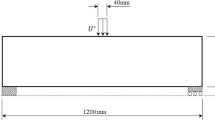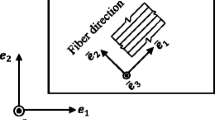Abstract
An alternative strain energy method is proposed for the prediction of effective elastic properties of orthotropic materials in this paper. The method is implemented in the topology optimization procedure to design cellular solids. A comparative study is made between the strain energy method and the well-known homogenization method. Numerical results show that both methods agree well in the numerical prediction and sensitivity analysis of effective elastic tensor when homogeneous boundary conditions are properly specified. Two dimensional and three dimensional microstructures are optimized for maximum stiffness designs by combining the proposed method with the dual optimization algorithm of convex programming. Satisfactory results are obtained for a variety of design cases.
Similar content being viewed by others
References
Bensoussan A., Lions J.L. and Papanicolaou G. (1978). Asymptotic Analysis for Periodic structures. North Holland, Amsterdam
Fazekas A., Dendieveel R., Salvo L. and Bréchet Y. (2002). Effect of microstructural topology upon the stiffness and strength of 2D cellular structures. Int. J. Mech. Sci. 44: 2047–2066
Hashin Z. (1983). Analysis of composite materials. J. Appl. Mech. T ASME 50: 481–505
Hassani B. and Hinton E. (1998). A review of homogenization and topology optimization II—analytical and numerical solution of homogenization equations. Comput. Struct. 69: 719–738
Hazanov S. (1998). Hill condition and overall properties of composites. Arch. Appl. Mech. 68: 385–394
Hohe J. and Becker W. (2002). Effective stress-strain relations for two-dimensional cellular sandwich cores: Homogenization, material models and properties. Appl. Mech. Rev. 55(1): 61–87
Kalamkarov A.L. and Georgiades A.V. (2002). Modeling of smart composites on account of actuation, thermal conductivity and hygroscopic absorption. Compos. Part B-Eng. 33: 141–152
Nemat-Nasser S. and Hori M. (1993). Micromechanics: Overall Properties of Heterogeneous Materials. North-Holland, London
Sanchez-Palencia E. (1980). Non-homogeneous Media and Vibration Theory. Lecture Notes in Physics, vol. 127. Springer, Heidelberg
Vigdergauz S. (2001). The effective properties of a perforated elastic plate. Numerical optimization by genetic algorithm. Int. J. Solids Struct. 38: 8593–8616
Gibson L.J. and Ashby M.F. (1997). Cellular Solids: Structure and Properties. Cambridge University Press, Cambridge
Sigmund O. (1994). Materials with prescribed constitutive parameters: an inverse homogenization problem. Int. J. Solids Struct. 31(17): 2313–2329
Sigmund O. (1995). Tailoring materials with prescribed elastic properties. Mech. Mater. 20(4): 351–368
Silva E., Nishiwaki S., Fonseca J. and Kikuchi N. (1999). Optimization methods applied to material and flextensional actuator design using the homogenization method. Comput. Method Appl. M 172: 241–271
Neves M.M., Sigmund O. and Bendsoe M.P. (2002). Topology optimization of periodic microstructures with a penalization of highly localized buckling modes. Struct. Multidiscip. O 54: 809–834
Pedersen N. (2000). Maximization of eigenvalue using topology optimization. Struct. Multidiscip O 20(1): 2–11
Sigmund O. and Torquato S. (1997). Design of materials with extreme thermal expansion using a three-phase topology optimization method. J. Mech. Phys. Solids 45: 1037–1067
Zhang W.H. and Duysinx P. (2003). Dual approach using a variant perimeter constraint and efficient sub-iteration scheme for topology optimization. Comput. Struct. 81(22/23): 2173–2181
Author information
Authors and Affiliations
Corresponding author
Additional information
The project supported by the National Natural Science Foundation of China (10372083, 90405016), 973 Program (2006CB601205) and the Aeronautical Science Foundation (04B53080). The English text was polished by Keren Wang.
Rights and permissions
About this article
Cite this article
Zhang, W., Dai, G., Wang, F. et al. Using strain energy-based prediction of effective elastic properties in topology optimization of material microstructures. Acta Mech Sin 23, 77–89 (2007). https://doi.org/10.1007/s10409-006-0045-2
Received:
Revised:
Accepted:
Published:
Issue Date:
DOI: https://doi.org/10.1007/s10409-006-0045-2




